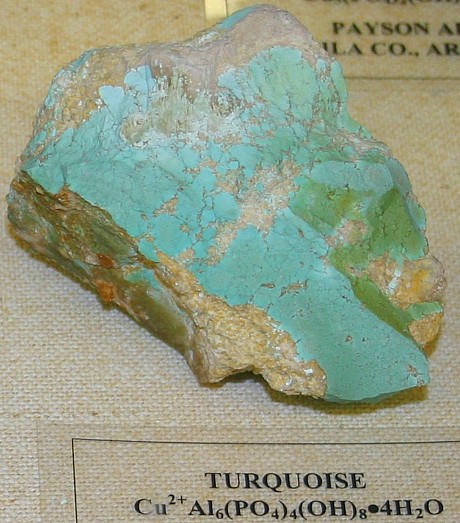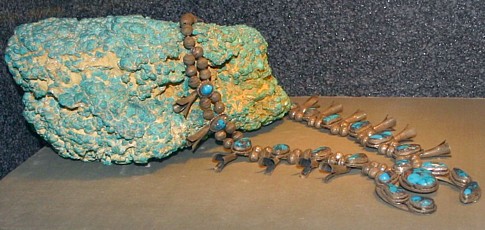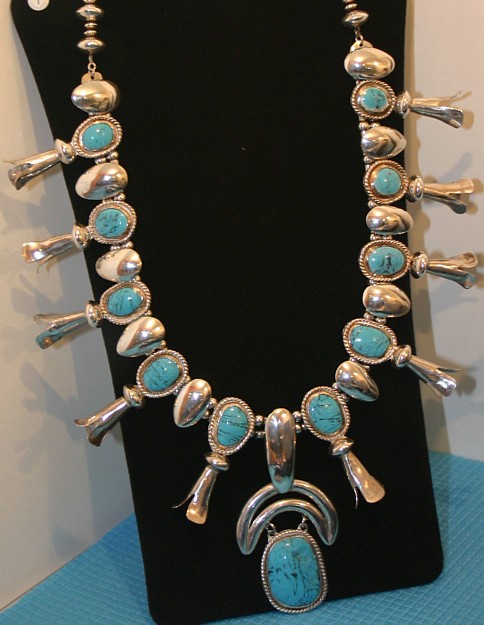|
.
Turquoise
Mineral Facts:
Chemical
Formula: CuAl6 (PO4)4 (OH)8:4H2O
Color: Blue,
Bluish-green, green.
Hardness: 6
Note that turquoise nearly always
occurs as a cryptocrystalline aggregate, and can vary from dense compact
forms to porous chalky forms. The hardness given is the hardness for
single crystals, which are rare. The hardness of the dense forms
approaches the hardness of the single crystal, but the porous chalky
forms may give an apparent hardness as low as 1. Therefore, field
identification of turquoise should not be made based on hardness as the
apparent readings can be misleading.
Density: 2.6
to 2.8
For the reasons noted under hardness
above, turquoise density readings may vary from readings in the range
given here (for compact forms) to much lower apparent densities for the
porous chalky forms.
Cleavage:
One Perfect
cleavage on 001 and one good cleavage on 010, these are rarely seen as
visible crystals are uncommon.
Crystallography: Triclinic
Optics:
(Refractive Index) a = 1.61; b = 1.62; y = 1.65
|

Turquoise - Blue and
green colors |
|
Composition,
Structure and Associated Minerals:
Turquoise occurs as a
secondary mineral in rocks with significant copper and phosphate
content. It normally appears filling spaces such as small cracks and
other openings. It can also occur as botryoidal aggregations filling
spaces in mud filled zones. Associated minerals are also secondary, and
a complete solution exists between Chalcosiderite, CuFe6 (PO4)4
(OH)8:4H2O, and turquoise CuAl6
(PO4)4 (OH)8:4H2O. In
places, variscite and turquoise also occur together. While no solid
solution exists between the two, it is not uncommon that specimens may
contain an aggregate of both crystals as a mix of both variscite and
turquoise crystals can be precipitated from a solution if it is poor in
copper. Other secondary minerals such as Limonite (iron oxides) and
secondary silica commonly occur mixed with the turquoise, both as a
matrix and precipitated within the turquoise cryptocrystalline aggregate
mix.
Identification and Diagnostics
Turquoise is not often confused
with
Malachite or
azurite, although some specimens of these two copper
carbonates can take forms similar to turquoise.
Chrysocolla is the most
common mineral of similar appearance to turquoise. Both chrysocolla and
turquoise form earthy to compact masses in light to medium blue tones,
so hardness or density tests to differentiate between the two are not
reliable. Far more useful is the fact that turquoise gives a positive
test for phosphate, which chrysocolla will not.
In some deposits, both turquoise and
variscite occur, which can lead
to identification difficulties. Because of the typical green tones of
variscite, it can be difficult to differentiate between the two by color
alone. In comparison with variscite, turquoise will give a positive test
for copper, which variscite will not. Green tones in turquoise usually
indicate the presence of more or less iron in the material, and partial
replacement of the turquoise by
chalcosiderite. Another mineral of
similar appearance and found in the same type of environment is Faustite,
a copper zinc aluminum phosphate. Faustite tends to have a more
yellow-green appearance.
Testing for the presence of
Copper or Phosphates
FOR COPPER:
The standard test for copper is to
scratch or grind the mineral (if you are testing sulfides rather than
turquoise they have to be roasted or oxidized first) and then put the
powder in a few drops of Hydrochloric acid. Allow the mix to sit for an
hour or so. Then put a drop of the powder-acid mix in a natural gas
flame. The flame should turn a bright blue green from the presence of
Copper Chloride if copper was present in the original mineral powder. If
the Copper content is high, you will see the blue green color of the
copper chloride in the acid solution even before it is put into the
flame.
FOR PHOSPHATES: The
mineral is crushed to a powder and dissolved in nitric acid (heating for
digestion may be required). A few drops of the dissolved mineral
solution are added to an Ammonium Molybdate solution. A precipitate of
bright yellow ammonium phosphomolybdate indicates the presence of
phosphorus.
SAFETY NOTE ON
CHEMICAL TESTS: These tests are given as reference material only.
Chemicals can be dangerous and those not well versed in chemistry and
the potential hazards of these acids and any other chemical reactions
that might occur, should not perform these tests.
If you would like to see some
photos of our Nevada turquoise mines, and get a feel for what a turquoise mine
looks like out in the field, then take a look at our
TURQUOISE MINE TOUR PAGE. If you'd like to see our silver turquoise jewelry,
or just get a piece of natural Nevada turquoise for yourself, you can take a
look here:
TURQUOISE JEWELRY If you'd
like to see some of the turquoise cabochons that have been produced from our
mines, you can take a look at this page:
TURQUOISE CABOCHONS
Return to the
Mineral Collectors Information Page |
 |
|



